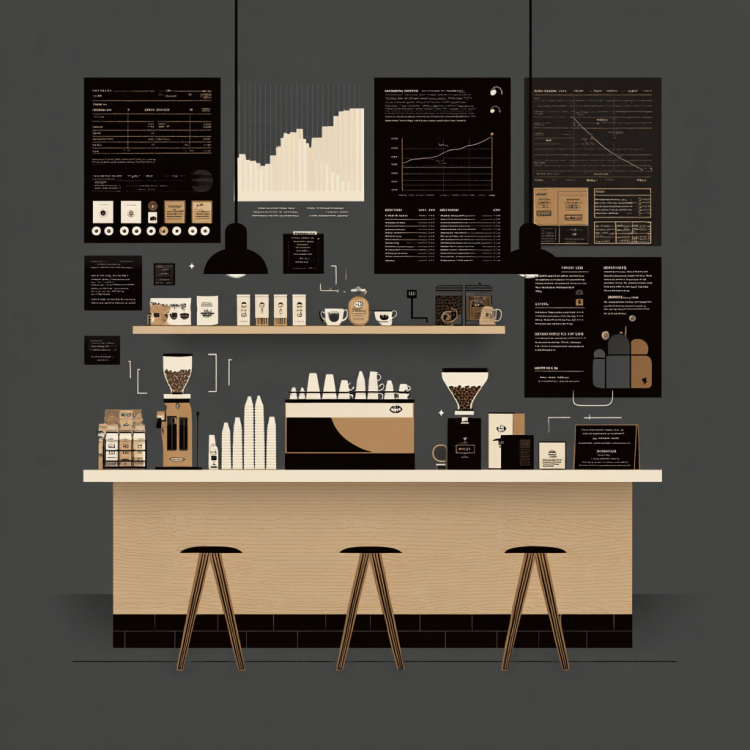The American coffee industry has long been dominated by household names like Starbucks and Dunkin’, but 2025 has proven to be a watershed year that’s reshaping the entire sector. What was once a predictable market controlled by a few major players has transformed into a battlefield where traditional giants face unprecedented challenges from multiple fronts. The convergence of labor disputes, political controversies, supply chain disruptions, and aggressive competition from smaller chains has created a perfect storm that’s testing the limits of even the most sophisticated PR strategy implementations.
In 2025, the American coffee industry is experiencing a significant shift as traditional giants like Starbucks and Dunkin' face declining market share amid rising challenges from smaller chains. This transformation reflects changing consumer preferences for community connection and ethical sourcing. Starbucks struggles with labor disputes and political controversies, drawing increased scrutiny. Digital communication and authentic corporate values have become essential, revealing that successful brands must adapt to evolving expectations to maintain market positions.
The stakes couldn’t be higher. The coffee industry represents a multi-billion dollar market where brand loyalty and public perception directly translate to bottom-line results. For decades, major chains relied on consistent expansion, familiar branding, and aggressive business marketing to maintain their dominance. However, recent events have demonstrated that traditional approaches to food and beverage PR are no longer sufficient in addressing the complex, interconnected challenges facing these corporate giants.
This transformation isn’t merely about individual company struggles; it represents a fundamental shift in how consumers interact with brands, how employees view their employers, and how corporate America responds to social and political pressures. The coffee industry has become a microcosm of broader business challenges, where digital advertising campaigns must compete with grassroots movements, and where a single misstep can trigger nationwide boycotts that persist for months.
Table of Contents
The Erosion of Market Dominance
The most striking development in the coffee industry has been the measurable decline in market share among the traditional powerhouses. Starbucks and Dunkin’, which together commanded 85.9% of the market in 2019, saw their combined dominance slip to 77.9% by 2024, representing a significant erosion of their previously unassailable position. This eight-percentage-point decline might seem modest, but in an industry worth tens of billions of dollars, it represents massive revenue shifts and signals a fundamental change in consumer behavior.
Starbucks, in particular, has experienced challenges that would have been unthinkable just a few years ago. The company posted a negative 0.5% decline in sales growth, placing it among just 12% of top coffee chains experiencing negative growth. This performance stands in stark contrast to the company’s historical trajectory of consistent expansion and growth, highlighting how external pressures can impact even the most established brands in the coffee industry.
The data reveals a more nuanced story about changing consumer preferences. While major chains struggle, smaller coffee shops are experiencing remarkable growth in customer engagement metrics. Visit duration at small chains increased by 13.4%, while the same metric declined by 8.9% at Starbucks and Dunkin’ locations. This shift suggests that consumers are increasingly valuing the experience and atmosphere that smaller establishments provide, challenging the convenience-focused business model that has driven the success of major chains.
These market dynamics have forced major chains to reconsider their entire approach to business marketing and customer engagement. The traditional focus on speed and efficiency, while still important for many customers, is no longer sufficient to maintain market dominance. Companies are discovering that their PR strategy must evolve to address not just product quality and convenience, but also corporate values, employee treatment, and social responsibility.
The competitive field has become increasingly complex as smaller chains leverage their agility and local connections to compete directly with industry giants. These emerging competitors often operate with lower overhead costs, enabling them to offer competitive pricing while maintaining higher profit margins. More importantly, they frequently demonstrate greater flexibility in responding to local community needs and preferences, creating stronger emotional connections with their customer base.
Starbucks: A Case Study in Crisis Management
Starbucks has found itself at the epicenter of multiple controversies, creating a complex web of challenges that has tested every aspect of the company’s food and beverage PR capabilities. The company’s struggles illustrate how modern corporations must manage an increasingly complex framework where labor relations, political positions, and operational decisions are all subject to intense public scrutiny and can rapidly escalate into major PR crises.
The unionization efforts across Starbucks locations have created one of the most persistent challenges facing the company. Workers at hundreds of locations have been pushing for union representation, leading to highly publicized conflicts between management and employees. These disputes have generated negative coverage across traditional and social media platforms, with union supporters organizing boycotts and protests that have directly impacted store operations and brand perception.
The company’s response to these labor disputes has been closely scrutinized, with critics arguing that corporate resistance to unionization efforts contradicts Starbucks’ publicly stated values regarding worker empowerment and social responsibility. This disconnect between corporate messaging and perceived actions has created credibility issues that extend far beyond the immediate labor disputes, affecting the company’s broader reputation among socially conscious consumers.
Political controversies have added another layer of complexity to Starbucks’ challenges. The company has faced boycotts related to its perceived stance on various international conflicts, with consumers on different sides of political issues calling for boycotts based on their interpretation of corporate actions or statements. These politically motivated boycotts demonstrate how quickly companies can become entangled in divisive issues, regardless of their intended neutrality.
Supply chain disruptions have created operational challenges that have translated into customer service issues and negative publicity. Reports of ingredient shortages, delivery delays, and inconsistent product availability have frustrated customers and provided ammunition for competitors seeking to highlight their superior reliability. These supply chain problems have required extensive crisis communication efforts and have highlighted the vulnerability of large-scale operations to disruption.
The Christmas Eve walkout at over 300 Starbucks locations represented a particularly visible manifestation of employee dissatisfaction, generating widespread media coverage during one of the busiest shopping periods of the year. This coordinated action demonstrated the organizational capability of disaffected employees and highlighted how labor disputes can be strategically timed to maximize impact and media attention.
Employee walkouts and strikes have become recurring themes, with each incident generating fresh negative coverage and reinforcing perceptions of internal discord. These events have required sophisticated crisis management responses, including careful messaging to various stakeholder groups and efforts to minimize operational disruptions while addressing underlying concerns.

The Rise of Competitive Alternatives
The challenges facing major chains have created opportunities for smaller competitors to gain significant market share and establish stronger footholds in the coffee industry. These emerging players are leveraging the vulnerabilities of larger competitors while capitalizing on changing consumer preferences and expectations.
Independent coffee shops and smaller regional chains are increasingly positioning themselves as alternatives to corporate giants, emphasizing qualities like community connection, ethical sourcing, and personalized service. These competitors often operate with greater flexibility, enabling them to respond quickly to local preferences and market conditions without facing complex corporate bureaucracies.
The success of smaller competitors reflects a broader trend toward supporting local businesses and seeking authentic experiences. Many consumers are actively choosing to patronize establishments that align with their values, even if it means sacrificing some convenience or paying slightly higher prices. This shift has created opportunities for businesses that can effectively communicate their values and demonstrate genuine commitment to their communities.
Digital advertising has become crucial for smaller chains seeking to compete with the marketing budgets of major corporations. Social media platforms enable these businesses to reach target audiences directly and build engaged communities around their brands. Many successful smaller chains have leveraged user-generated content, influencer partnerships, and local community engagement to build strong online presences that rival those of much larger competitors.
The competitive field has also been shaped by changing work patterns and lifestyle preferences. The rise of remote work has altered coffee consumption patterns, with many consumers seeking spaces that accommodate longer visits and provide conducive environments for work or social interaction. Smaller chains have often been more successful in creating these environments, offering comfortable seating, reliable Wi-Fi, and atmospheres that encourage longer stays.
Strategic Response Through Public Relations
Major coffee chains have responded to these challenges by implementing comprehensive PR strategies designed to address multiple crisis points simultaneously while rebuilding brand credibility and market position. These efforts demonstrate the critical role that strategic communication plays in business marketing during periods of significant challenge and change.
Crisis management has become a core competency for major chains, requiring sophisticated communication strategies that can address multiple audiences with different concerns and expectations. Companies must balance the needs of customers, employees, investors, and community stakeholders while maintaining consistent messaging that supports overall brand positioning.
The approach to managing labor-related controversies requires particularly nuanced communication strategies. Companies must acknowledge legitimate employee concerns while defending their business practices and maintaining operational continuity. This balancing act often involves extensive dialogue with various stakeholder groups and careful coordination between HR, legal, and communications teams.
Political neutrality has become increasingly difficult to maintain, but major chains continue to attempt to position themselves as focused on their core business rather than political issues. This approach requires careful message discipline and consistent application across all communication channels, from executive statements to social media responses.
Transparency initiatives have become essential components of food and beverage PR strategies, with companies sharing more information about their supply chains, labor practices, and corporate decision-making processes. These efforts aim to rebuild trust by demonstrating accountability and responsiveness to stakeholder concerns.
Corporate social responsibility messaging has been enhanced to address criticism about company values and practices. Major chains are investing in programs and initiatives that demonstrate commitment to social and environmental causes, while ensuring that these efforts are substantive rather than merely performative.
Digital advertising campaigns have been redesigned to focus on authentic storytelling and genuine customer experiences rather than purely promotional content. This shift reflects recognition that modern consumers are more sophisticated and skeptical of traditional advertising approaches.

The Evolution of Consumer Expectations
The challenges facing major coffee chains reflect broader changes in consumer expectations and behavior that extend far beyond the coffee industry. Modern consumers increasingly expect brands to demonstrate authentic commitment to social and environmental values, creating new standards for corporate behavior and communication.
Social media has amplified consumer voices and created new mechanisms for organizing collective action against companies that fail to meet evolving expectations. Boycotts can now be organized and executed with unprecedented speed and scale, making it essential for companies to monitor public sentiment continuously and respond quickly to emerging concerns.
The expectation for corporate transparency has grown significantly, with consumers demanding detailed information about supply chains, labor practices, environmental impact, and corporate governance. This trend has forced companies to share information that was previously considered proprietary, creating new vulnerabilities while potentially building stronger trust relationships with stakeholders.
Employee treatment has become a significant factor in consumer decision-making, with many customers actively choosing to support businesses that demonstrate respect for their workers. This shift has elevated labor relations from an internal corporate matter to a public-facing brand issue that directly impacts customer loyalty and market position.
Quality expectations have also evolved, with consumers becoming more sophisticated about coffee preparation, sourcing, and presentation. This knowledge has created opportunities for smaller competitors that can offer superior products or unique experiences, while challenging major chains to continuously improve their offerings.
The demand for authentic experiences has grown as consumers seek alternatives to standardized corporate environments. This preference has advantaged smaller chains and independent shops that can offer unique atmospheres and personalized service, forcing major chains to reconsider their approach to store design and customer interaction.
Digital Communication in Crisis Management
The role of digital platforms in shaping public perception has fundamentally altered how companies must approach crisis communication and ongoing brand management. Social media platforms serve as both battlegrounds for public opinion and essential tools for reaching target audiences with corporate messaging.
Real-time communication has become essential, with companies expected to respond to developing situations within hours rather than days. This expectation requires sophisticated monitoring systems and pre-approved response protocols that enable rapid deployment of appropriate messaging across multiple platforms simultaneously.
Digital advertising strategies must now account for the possibility that paid promotional content will appear alongside negative organic content about the same company. This juxtaposition can undermine marketing effectiveness and requires careful consideration of timing, placement, and messaging to avoid appearing tone-deaf or insensitive.
User-generated content has become a double-edged sword, providing opportunities for authentic customer endorsements while also creating platforms for criticism and negative experiences to gain widespread attention. Companies must develop strategies for encouraging positive user-generated content while effectively responding to negative posts and reviews.
Influencer partnerships have become more complex as influencers face their own scrutiny regarding the brands they choose to promote. Companies must carefully vet potential partnerships and maintain ongoing monitoring to ensure that influencer relationships don’t create additional reputation risks.
The permanence of digital content means that crisis-related information remains accessible indefinitely, requiring companies to consider the long-term implications of their communication strategies rather than focusing solely on immediate damage control.

Supply Chain Transparency and Communication
Supply chain disruptions have highlighted the importance of operational transparency in maintaining customer trust and brand credibility. Companies that can effectively communicate about challenges while demonstrating proactive problem-solving tend to maintain stronger customer relationships during difficult periods.
The complexity of modern supply chains creates communication challenges, as companies must explain sophisticated logistics and sourcing decisions to consumers who may have limited understanding of these processes. Effective food and beverage PR requires translating complex operational realities into accessible explanations that build rather than undermine confidence.
Proactive communication about potential supply chain issues has become a best practice, with companies choosing to inform customers about possible disruptions before they occur rather than waiting for problems to become apparent. This approach demonstrates transparency while managing expectations and reducing customer frustration.
Supplier relationships have become part of brand storytelling, with companies highlighting partnerships with specific farms, cooperatives, or regional suppliers to demonstrate commitment to quality and ethical sourcing. These relationships provide content for marketing campaigns while supporting broader corporate social responsibility messaging.
Investment in supply chain resilience has become a competitive advantage that companies can leverage in their business marketing. Demonstrating superior reliability and consistency can differentiate brands in crowded markets where price and convenience are increasingly commoditized.
Labor Relations as Brand Positioning
The intersection of labor relations and brand perception has become one of the most challenging aspects of corporate communication in the coffee industry. Companies must balance operational needs with employee satisfaction while maintaining positive public perception among customers who increasingly care about worker treatment.
Employee satisfaction surveys and internal communication have become external PR considerations, as disgruntled employees can quickly share negative experiences through social media and review platforms. This reality requires companies to consider the PR implications of internal policies and practices.
Wage and benefit policies have become marketing messages, with companies highlighting competitive compensation packages and employee development programs as differentiating factors. This trend reflects growing consumer awareness of labor issues and willingness to support companies that treat employees well.
Union relations require sophisticated communication strategies that acknowledge legitimate worker concerns while explaining company positions and policies. These communications must be carefully crafted to avoid legal issues while maintaining positive relationships with various stakeholder groups.
Employee advocacy programs have become valuable PR tools, with satisfied employees serving as authentic brand ambassadors who can counter negative publicity and provide credible testimonials about company culture and values.
The Future of Food and Beverage PR
The challenges facing the coffee industry this year provide insights into the future direction of food and beverage PR and corporate communication more broadly. Companies must prepare for an environment where traditional boundaries between operational, legal, and communication challenges continue to blur.
Integration of crisis management into ongoing brand strategy has become essential, with companies needing to maintain crisis communication capabilities as core business functions rather than reactive services. This shift requires investment in monitoring systems, response protocols, and cross-functional teams that can address complex challenges quickly and effectively.
Stakeholder mapping has become more sophisticated, with companies needing to understand and address the concerns of increasingly diverse groups with different priorities and communication preferences. Effective PR strategy requires tailored messaging and channel selection that recognizes these differences while maintaining overall message consistency.
Measurement and evaluation of PR effectiveness must account for multiple variables and long-term brand impact rather than focusing solely on immediate media coverage or crisis resolution. Companies need comprehensive analytics that can assess the effectiveness of communication strategies across various stakeholder groups and time periods.
The investment in authentic corporate social responsibility programs has become a business necessity rather than a marketing luxury. Companies must demonstrate genuine commitment to social and environmental causes through substantive actions rather than superficial marketing campaigns.

Lessons for Industry Leadership
The experiences of major coffee chains in 2025 offer valuable lessons for business marketing and corporate communication across industries. The speed with which established brands can face serious challenges demonstrates the importance of continuous stakeholder engagement and proactive reputation management.
Diversification of communication channels has become essential, with companies needing to maintain an effective presence across traditional media, social media, direct customer communication, and employee communication platforms. This multi-channel approach requires significant resources and coordination but provides essential redundancy during crisis periods.
The importance of authentic leadership communication has grown significantly, with customers and employees expecting genuine, personal responses from corporate executives during challenging periods. Scripted or overly corporate communication often fails to build the trust necessary for effective crisis resolution.
Long-term reputation building remains more valuable than short-term crisis management, though both capabilities are necessary for modern corporations. Companies that invest consistently in stakeholder relationships and transparent communication are better positioned to weather challenges and maintain market position during difficult periods.
Moving Forward in a Changed Industry
The coffee industry this year represents a fundamental shift from the predictable growth patterns and market dynamics of previous decades. Major chains face ongoing challenges that require sophisticated PR strategy implementation and continuous adaptation to changing consumer expectations and competitive pressures.
The success of smaller competitors demonstrates that there are viable alternatives to the corporate chain model, creating pressure for continued innovation and improvement among industry leaders. This competitive pressure benefits consumers while forcing companies to continuously justify their market position through superior products, services, and corporate behavior.
Digital advertising and social media communication have become essential tools for all players in the coffee industry, regardless of size or market position. The democratization of marketing capabilities has leveled the competitive playing field while creating new challenges for companies seeking to differentiate themselves in crowded digital spaces.
The integration of corporate values with business operations has become a competitive necessity rather than an optional consideration. Companies that can authentically demonstrate commitment to employee welfare, environmental responsibility, and community engagement are likely to maintain stronger market positions than those that treat these issues as secondary concerns.
The resilience of the coffee industry despite ongoing challenges demonstrates the fundamental strength of consumer demand and the adaptability of businesses operating within this market. While individual companies may struggle, the overall industry continues to evolve and adapt to changing conditions, suggesting that the current challenges represent transformation rather than decline.
The lessons learned from the coffee industry’s challenges will likely influence business marketing and food and beverage PR strategies across multiple industries, as the intersection of operational challenges, social expectations, and digital communication creates new standards for corporate behavior and communication excellence.
References
- Coffee Business Intelligence. “Market Share Analysis: Major Coffee Chains 2019-2024.” Industry Report, 2024.
- Restaurant Industry Analytics. “Coffee Chain Performance Metrics Q4 2024.” Quarterly Business Review, 2024.
- Labor Relations Quarterly. “Starbucks Union Organizing Efforts: A Timeline.” Worker Rights Publication, 2025.
- Supply Chain Management Today. “Coffee Giant Supply Chain Disruptions.” Industry Analysis, 2025.
- Consumer Behavior Research Institute. “Changing Coffee Shop Visit Patterns 2024-2025.” Market Research Report, 2025.
- Digital Marketing Analytics. “Social Media Impact on Coffee Chain Reputation.” PR Analysis Report, 2025.
- Retail Industry Monitor. “Independent Coffee Shop Growth Trends.” Small Business Analysis, 2025.
- Crisis Communication Journal. “Corporate Response Strategies in Food Service Industry.” Academic Publication, 2025.
- Food Service Weekly. “Employee Walkout Coordination and Impact Analysis.” Industry News Analysis, 2025.
- Business Ethics Review. “Corporate Social Responsibility in Food and Beverage Sector.” Ethics Journal, 2025.
Cristina is an Account Manager at AMW, where she oversees digital campaigns and operational workflows, ensuring projects are executed seamlessly and delivered with precision. She also curates content that spans niche updates and strategic insights. Beyond client projects, she enjoys traveling, discovering new restaurants, and appreciating a well-poured glass of wine.


